Tired of Killing Your String of Pearls? This Is the Guide You Need.
I’ve been obsessed with succulents for ages, and I’ve seen so many plant fads come and go. But the one that always sticks around—and let’s be honest, stumps almost everyone at first—is the gorgeous String of Pearls.
In this article
- First, Respect the Plant’s Weird and Wonderful Design
- The Foundation: Your Soil and Pot Setup
- Watering: How to Not Drown Your Plant
- Getting the Light and Temperature Just Right
- Let’s Make More! How to Propagate String of Pearls
- A Little Bit of Fertilizer Goes a Long Way
- Emergency Room: Troubleshooting and First Aid
- Galerie d’inspiration
Oh yeah, I remember the first one I brought home. I treated it like any other houseplant, giving it a nice drink every week. A month later? It was a pile of gray, rotten mush. It was a tough lesson, but it taught me everything: to grow this plant, you have to stop thinking of it as a normal plant and start understanding what it’s actually built for.
This isn’t just some pretty trailing vine. It’s a highly specialized succulent from dry, rocky landscapes. Knowing this is the key. So in this guide, we’re going to skip the vague advice and get into what actually works, including the stuff most guides leave out, like propagation and what to do when things go wrong.
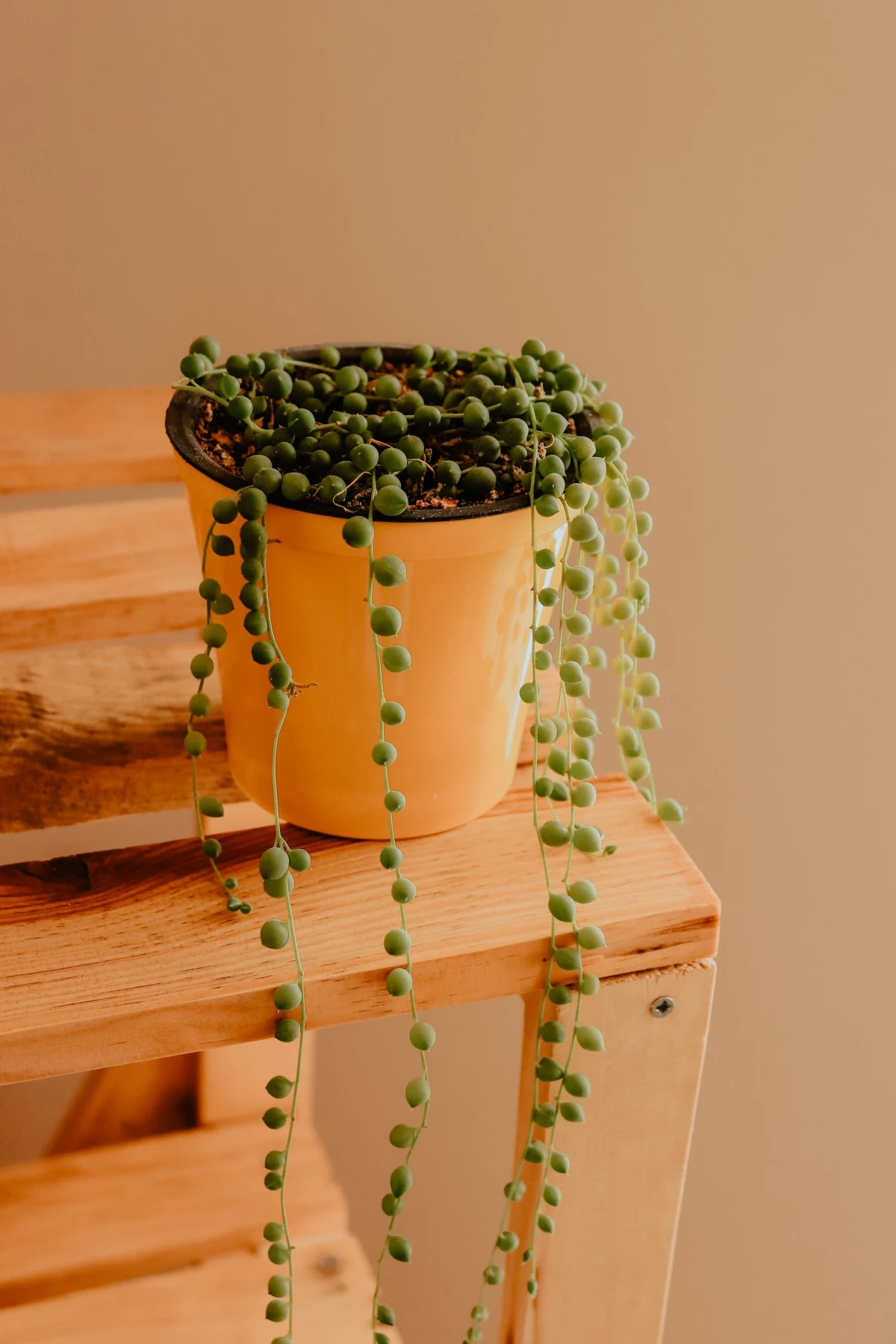
First, Respect the Plant’s Weird and Wonderful Design
To keep a String of Pearls happy, you have to appreciate its unique anatomy. Every single part of it is a masterclass in survival, and it’s nothing like the leafy pothos or fern in your living room. Once this clicks, you’re halfway there.
Those Little Green Peas are Water Tanks
The most obvious feature, of course, is the leaves. They aren’t just cute; their spherical shape is an evolutionary hack. A sphere gives you the most storage volume with the least amount of surface area, which dramatically cuts down on water loss from evaporation. It’s a lifesaver in its native arid environment. Each “pearl” is a tiny, self-contained water reservoir. When the plant is happy and hydrated, the pearls are firm and round. When it’s getting thirsty, they start to look a little deflated or even puckered.
The Secret ‘Window’ on Every Leaf
Look really closely at a healthy pearl. See that tiny, dark green or translucent slit on the side? That’s called an epidermal window, and it’s pure genius. In nature, this plant often grows shielded by rocks or larger shrubs to avoid being scorched by the sun. This little window allows sunlight to penetrate deep inside the leaf, supercharging photosynthesis from within. It’s a high-efficiency power system for a low-light life.

The Roots are Shallow and Fragile
Heads up! The root system on a String of Pearls is super fine and doesn’t go deep at all. It’s designed to quickly slurp up any moisture from dew or a brief shower. This is also its biggest weakness in your house. Because the roots are so shallow, they will rot in a heartbeat if the soil stays wet. This is why your soil and pot choice isn’t a friendly suggestion—it’s a matter of life and death for the plant.
The Foundation: Your Soil and Pot Setup
I can’t say this enough: the #1 fastest way to kill this plant is by using the wrong soil. That standard, all-purpose potting mix you get at the big-box store is a death sentence. It’s dense, holds way too much water, and will suffocate the roots.
DIY Soil Mix for Happy Roots
You can buy bags of “cactus and succulent soil,” but honestly, I find most of them still hold too much water for this particular plant. Mixing your own is cheap, easy, and gives you perfect results every time.
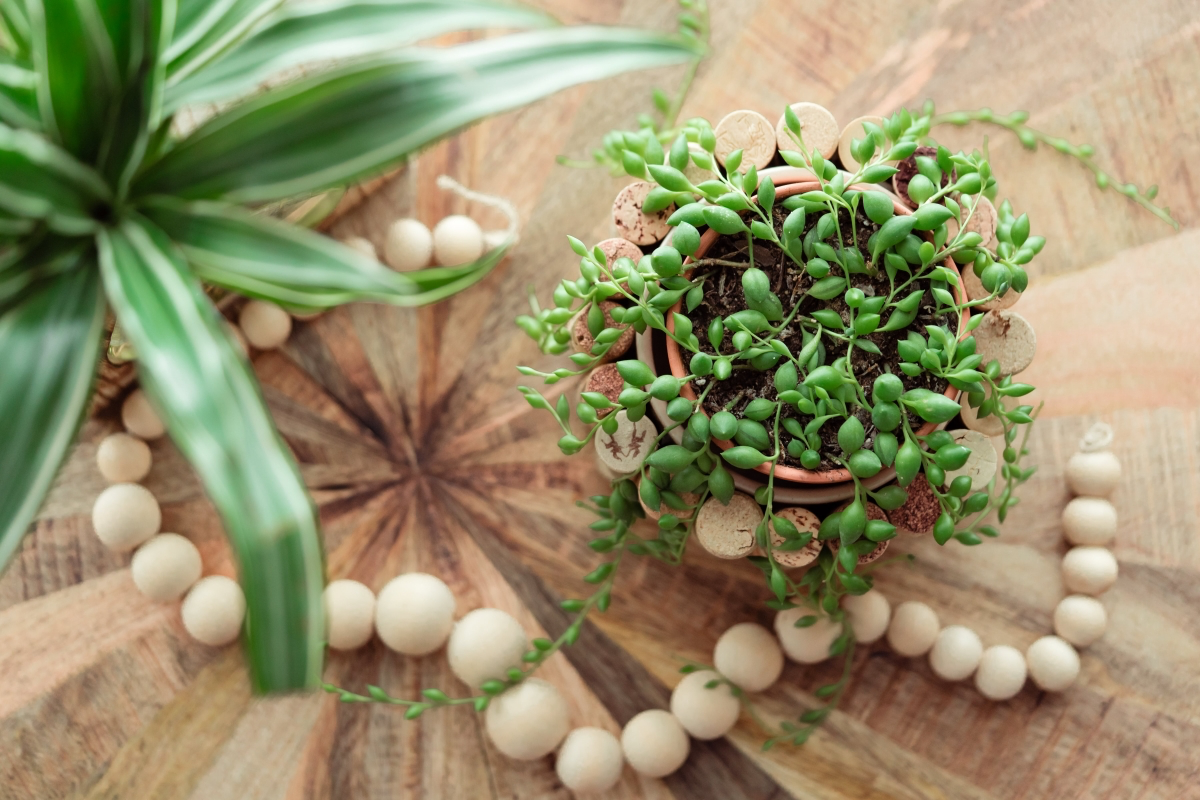
Here’s my go-to recipe:
- Two parts base soil: A basic cactus/succulent mix is a good starting point.
- One part perlite: Those little white, airy rocks are non-negotiable. They create air pockets, stop the soil from compacting, and let water drain right through.
- One part pumice or coarse sand: Pumice is a porous volcanic rock that adds great aeration. Coarse horticultural sand works too. Just make sure it’s not fine play sand, which will clog everything up.
Good to know: You can find perlite pretty much anywhere, but you might need to check a local garden nursery or order online to find pumice or coarse sand. A bag of perlite usually costs under $10 and will last you forever.
Choosing the Perfect Pot
The pot is just as crucial as the soil. Here are the rules:
- Drainage is mandatory. No drainage hole, no deal. If you find a cute decorative pot without one, use it as a “cachepot.” Just keep your plant in a cheap plastic nursery pot with holes, and pop that inside the decorative one.
- Shallow is better. Since the roots don’t run deep, a shallow pot is ideal. A big, deep pot holds a ton of soil that stays wet long after the plant is done drinking, which is a recipe for rot.
- Terracotta is your friend. I almost always use unglazed terracotta pots for these guys. Terracotta is porous, so it breathes, helping the soil dry out faster and more evenly. It provides a fantastic safety buffer against overwatering. A plastic or glazed ceramic pot will require you to be much more disciplined. A classic 4-inch terracotta pot usually costs between $5 and $8.
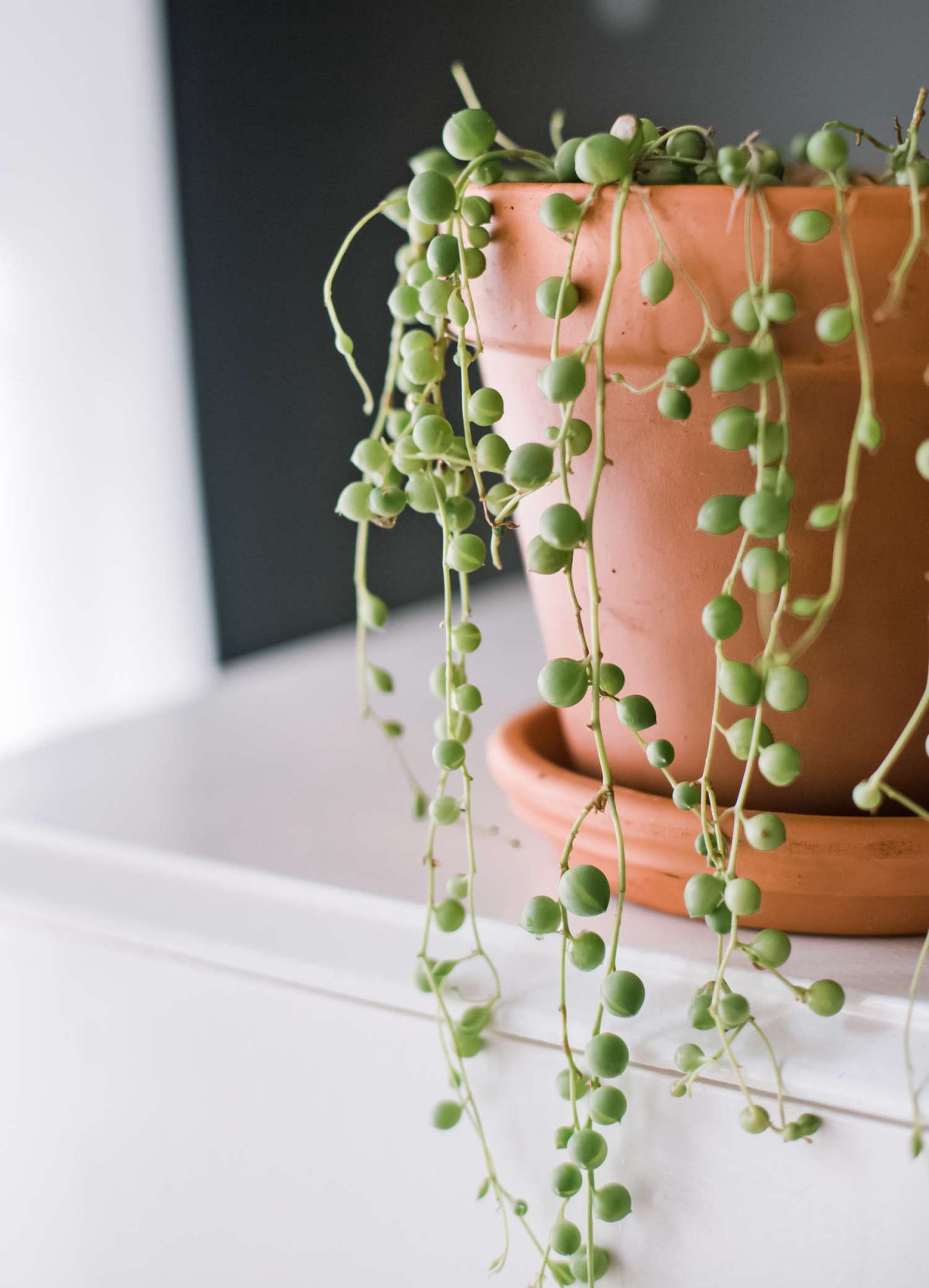
Watering: How to Not Drown Your Plant
If soil is the foundation, watering is the skill you have to master. More String of Pearls die from overwatering than anything else. Please, I’m begging you, throw away any advice that tells you to water on a schedule.
Let the Plant Tell You When It’s Thirsty
So how do you know it’s time? There are a few ways to check:
- The Finger Test: Stick your finger or a wooden chopstick deep into the soil. If it comes out with any hint of moisture or soil clinging to it, walk away. The soil needs to be bone-dry all the way through.
- The Weight Test: Pick up your plant right after you water it. Feel that heft? Now, pick it up every few days. You’ll be surprised how quickly you learn the difference between a heavy, wet pot and a lightweight, dry one.
- The Pearl Test: Look at the leaves! When it’s properly thirsty, the pearls will look a bit dull, slightly shrunken, or even a little flattened. This is your green light to water.

Overwatered vs. Underwatered: The Key Differences
It can be tough for beginners to tell the difference. A thirsty pearl looks deflated and a little wrinkly. An overwatered pearl, on the other hand, will look soft, translucent, and yellow or brown before turning to complete mush. One is asking for a drink; the other is already drowning.
Pro Tip: Water from the Bottom
I swear by bottom watering for this plant. The top of the soil where the stems emerge (the crown) is super sensitive to moisture and can easily rot. Bottom watering gets water right to the roots while keeping the crown perfectly dry.
It’s simple: Fill a bowl with a few inches of water, set the pot in it, and let it soak for about 15-20 minutes. You’ll see the soil on top darken as it wicks up the moisture. Once it’s done, take it out and let it drain completely before putting it back in its spot.
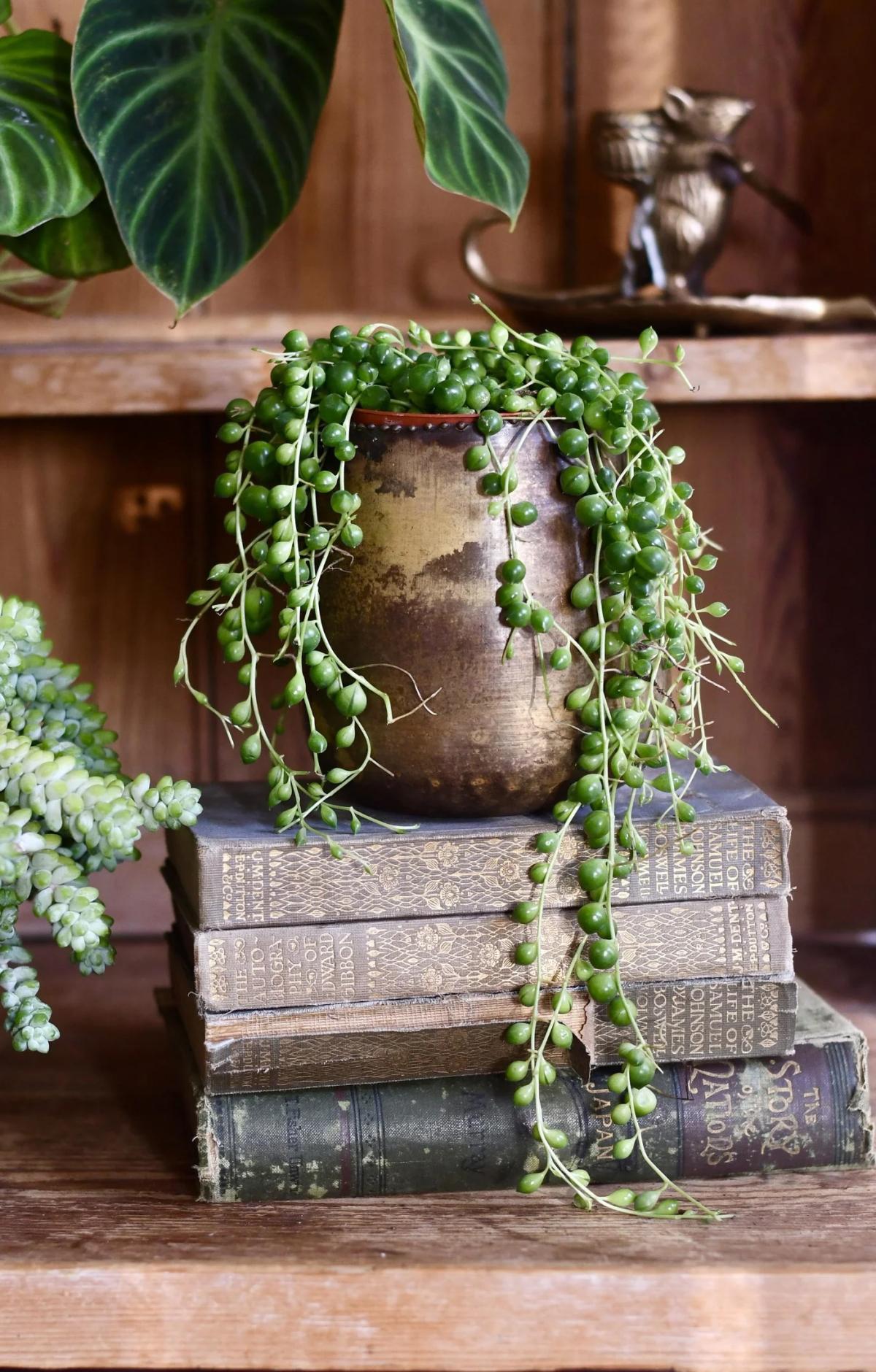
Getting the Light and Temperature Just Right
This plant needs bright, indirect light. But what does that actually mean?
Think about the spot right in an east-facing window that gets soft morning sun, or a spot a few feet back from a powerful south- or west-facing window. A north-facing window usually won’t be enough.
- Not enough light? The stems will get long and stretched out, with the pearls spaced far apart. The plant is literally reaching for more sun.
- Too much light? The pearls will get scorched and may turn a sickly yellow, brown, or even a stressed-out reddish color.
And if your home is a bit of a cave? A simple LED grow light is a total game-changer. Just position it about 6 to 12 inches away from the plant and run it for about 12 hours a day.
Let’s Make More! How to Propagate String of Pearls
One of the best things about this plant is how easy it is to make more—for free! It’s also the secret to fixing a plant that’s looking a little thin and “bald” on top.

The Easiest Propagation Method
- Take a cutting: Snip a healthy strand that’s at least 4-5 inches long.
- Let it callus: This is the most important step! Let the cut end dry out and form a callus for a day or two. This prevents it from rotting when you plant it.
- Lay it on the soil: Don’t bury the strand. Just lay it coiled on top of some fresh, dry succulent mix.
- Mist, don’t soak: Lightly mist the soil every few days until you see new roots forming. Once it’s rooted, you can water it normally.
A quick win for a fuller plant: Gently take one of the longest strands and loop it back onto the top of the soil in the same pot. You can use a bent paperclip to pin it down so the nodes make contact with the soil. It will root all along the stem, making the top of your plant look lush and full.
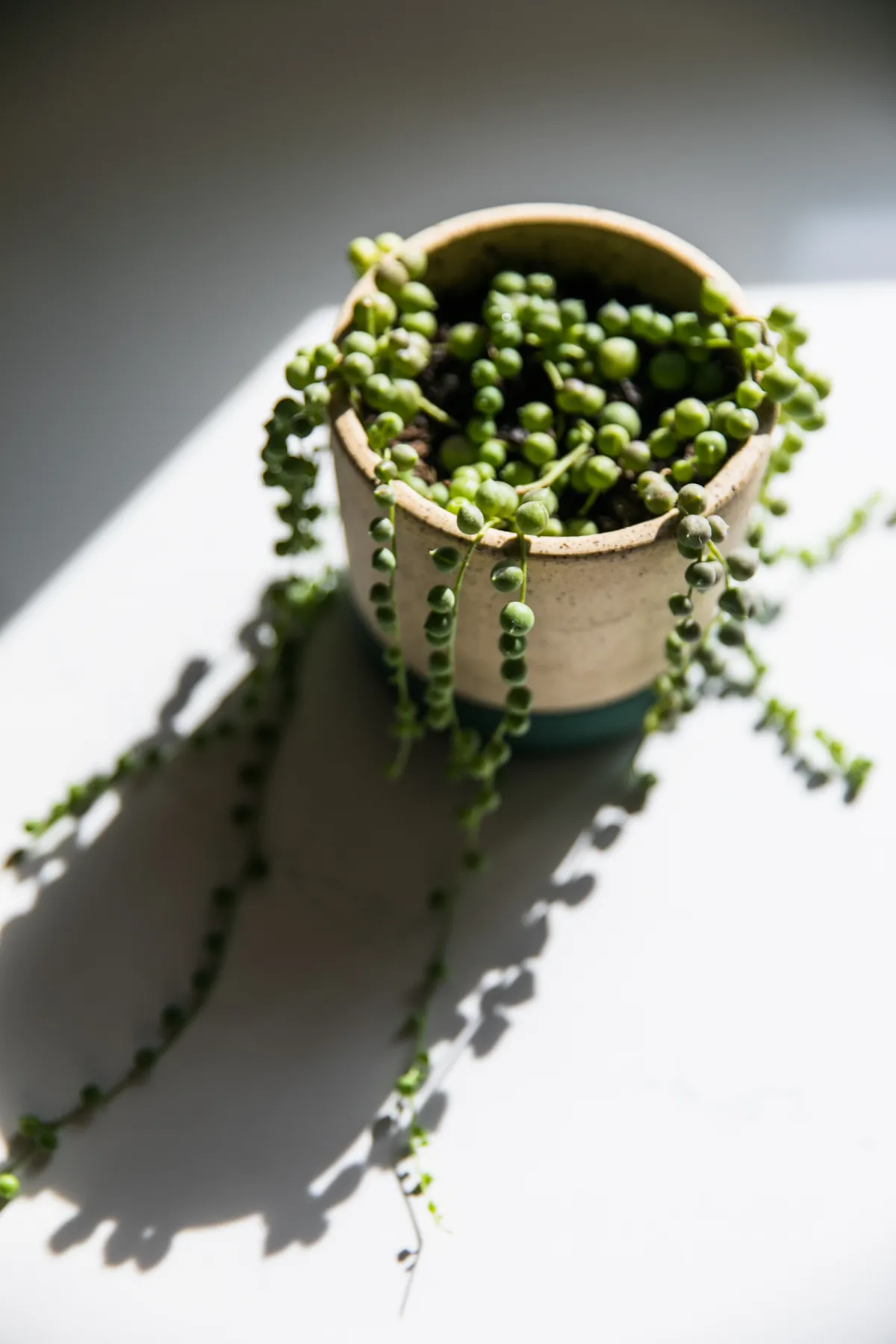
A Little Bit of Fertilizer Goes a Long Way
String of Pearls doesn’t need much food, but a little snack during the growing season (spring and summer) will encourage healthy growth. Use a balanced fertilizer made for cacti and succulents, but dilute it to half-strength. Feed it about once a month only when it’s actively growing. Never fertilize it in the fall or winter when it’s dormant.
Emergency Room: Troubleshooting and First Aid
Even with the best care, things can go wrong. Don’t panic!
- Help, it’s mushy! (Root Rot): If the base of your plant is yellow and squishy, you have root rot. Act fast! Take the plant out of the pot and gently trim away any black or mushy roots. Let the healthy strands dry out for a day, then repot them in fresh, completely dry soil. Don’t water it for at least a week.
- What’s this white fluffy stuff? (Mealybugs): Those little cotton-like specks are pests. The easiest fix is to dip a cotton swab in rubbing alcohol and touch each mealybug. It will dissolve them on contact. Check the plant every few days to make sure you got them all.
And that’s really it. Once you get the hang of its basic needs—gritty soil, infrequent watering, and bright, indirect light—you’ll find that the String of Pearls is actually a wonderfully rewarding and low-maintenance plant. You just have to learn its language.

Galerie d’inspiration

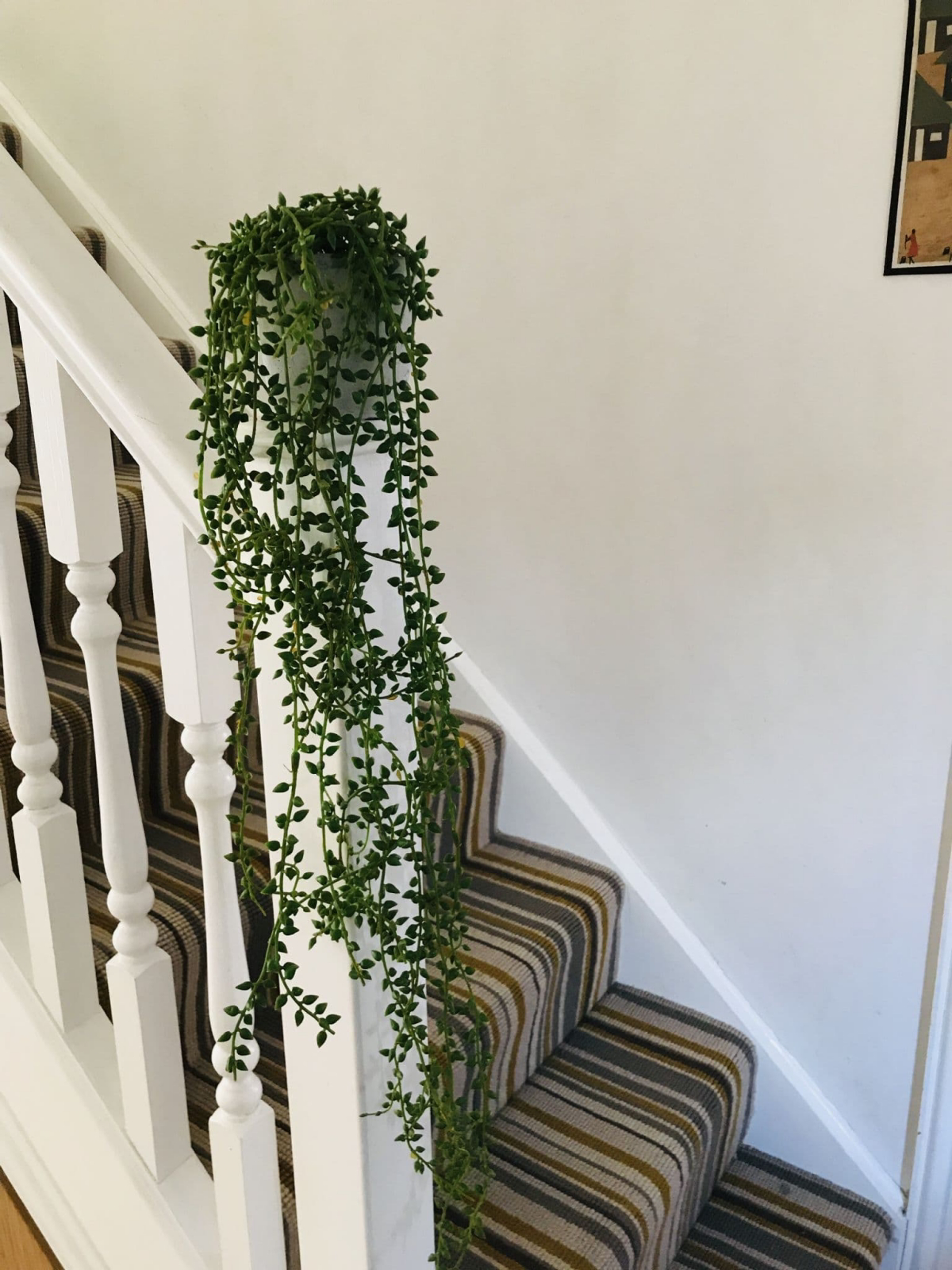
How can I tell if I’m watering correctly?
Forget the calendar. The plant itself will tell you when it’s thirsty. Gently squeeze one of the pearls near the soil. If it’s firm and full, it has plenty of water. If it feels slightly soft, looks a bit deflated, or has a puckered appearance, it’s time for a drink. This tactile check is far more reliable than a weekly schedule, as the plant’s needs change with light, humidity, and temperature. By waiting for this sign, you almost completely eliminate the risk of the dreaded root rot that kills so many of these beautiful succulents.
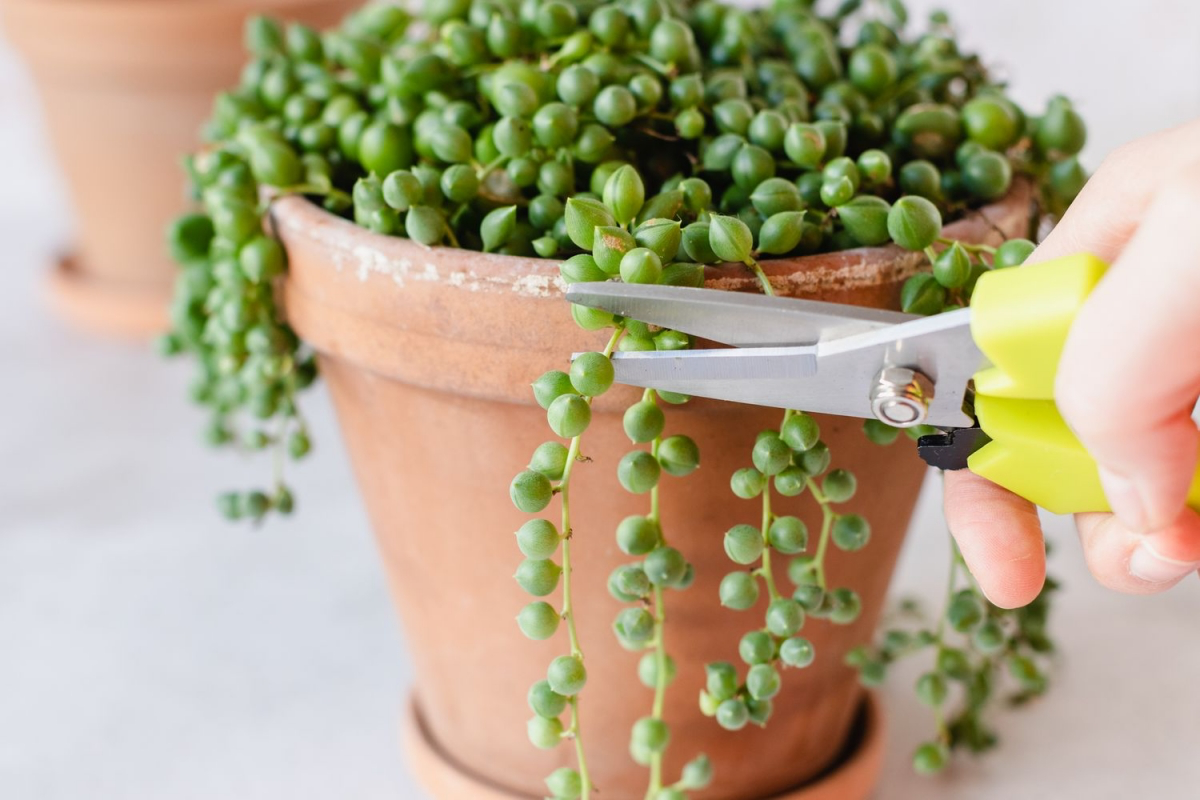
The biggest killer of a String of Pearls isn’t neglect—it’s the wrong soil. Standard potting mix holds too much moisture around its delicate, shallow roots.
The secret to a happy plant starts below the surface. Create an airy, fast-draining mix that mimics its native environment. A great DIY recipe is one part standard succulent/cactus soil, one part perlite for aeration, and one part coarse sand or pumice for drainage. If you’re not a fan of mixing your own, a pre-made gritty mix like the popular ones from Bonsai Jack or Superfly Bonsai provides the perfect chunky, arid-imitating substrate right out of the bag.
The High-Contrast Shelf: Place your String of Pearls in a shallow, wide terracotta pot on a high shelf or mantelpiece. The earthy color of the pot contrasts beautifully with the vibrant green pearls, while the elevation allows the strands to cascade elegantly down a clean wall.
The Bohemian Hanger: For a softer, more textured look, nestle the plant in a macrame or natural fiber hanging basket. This style complements its trailing nature and works perfectly in a bright corner or near a window, creating a living curtain of pearls.










